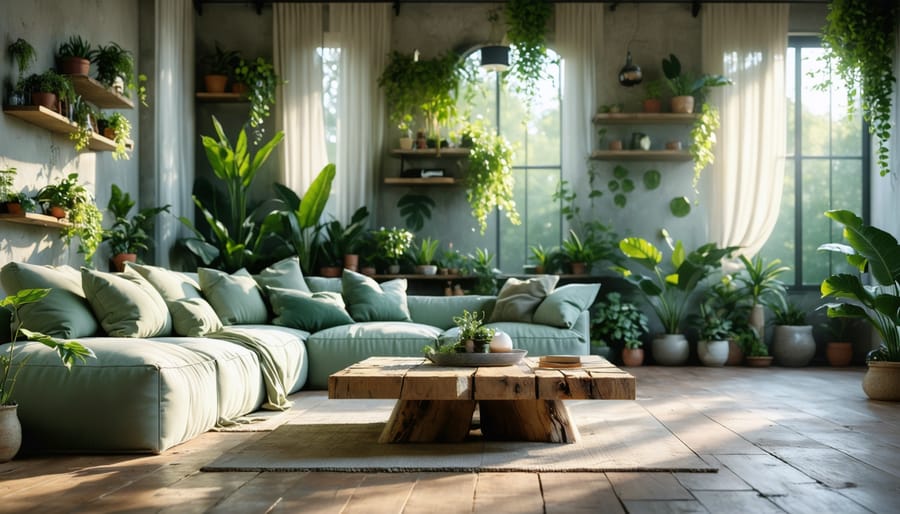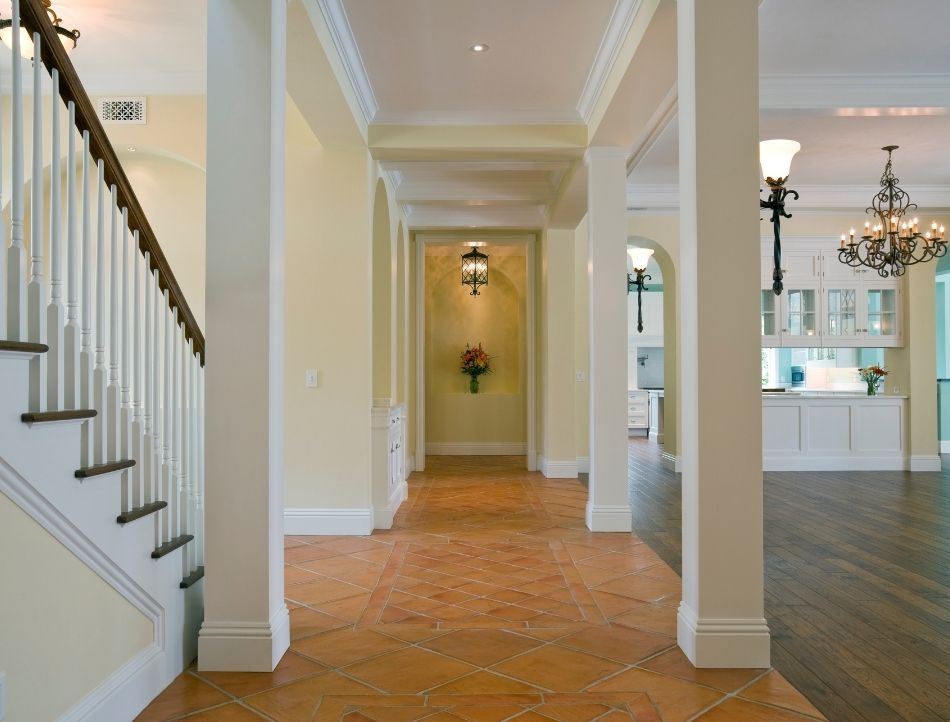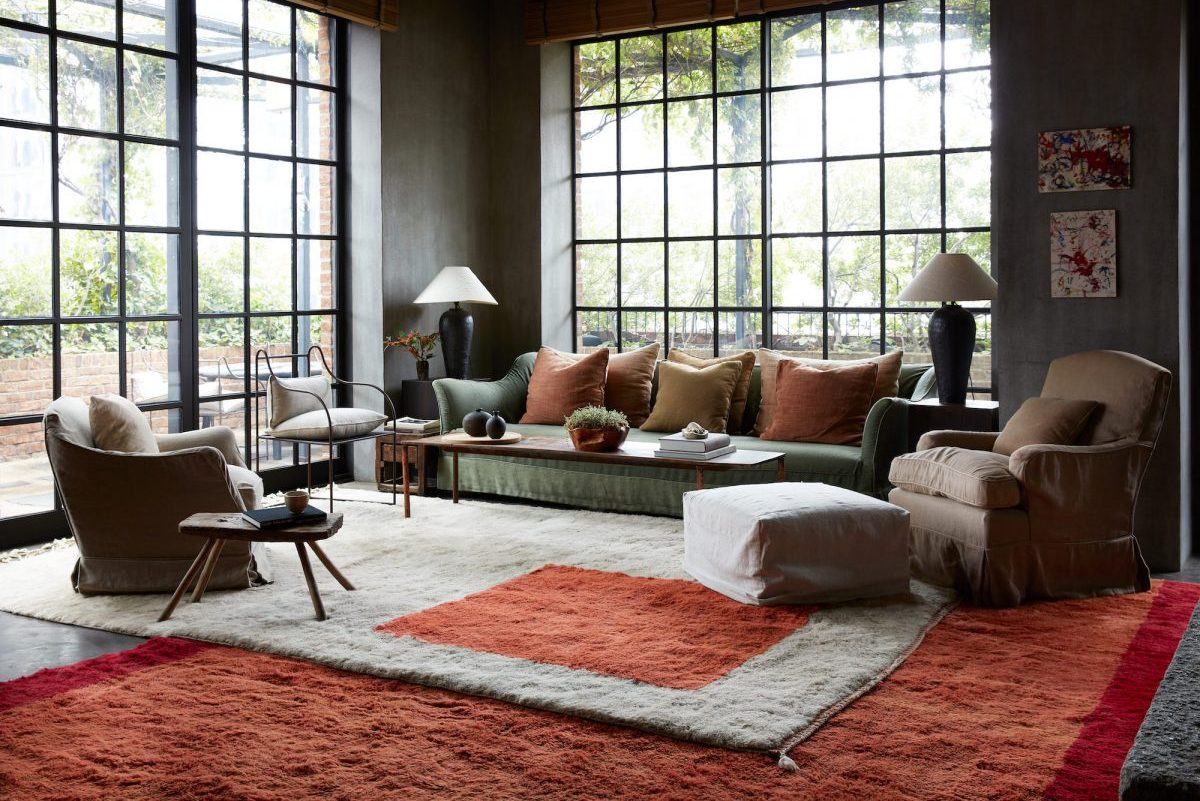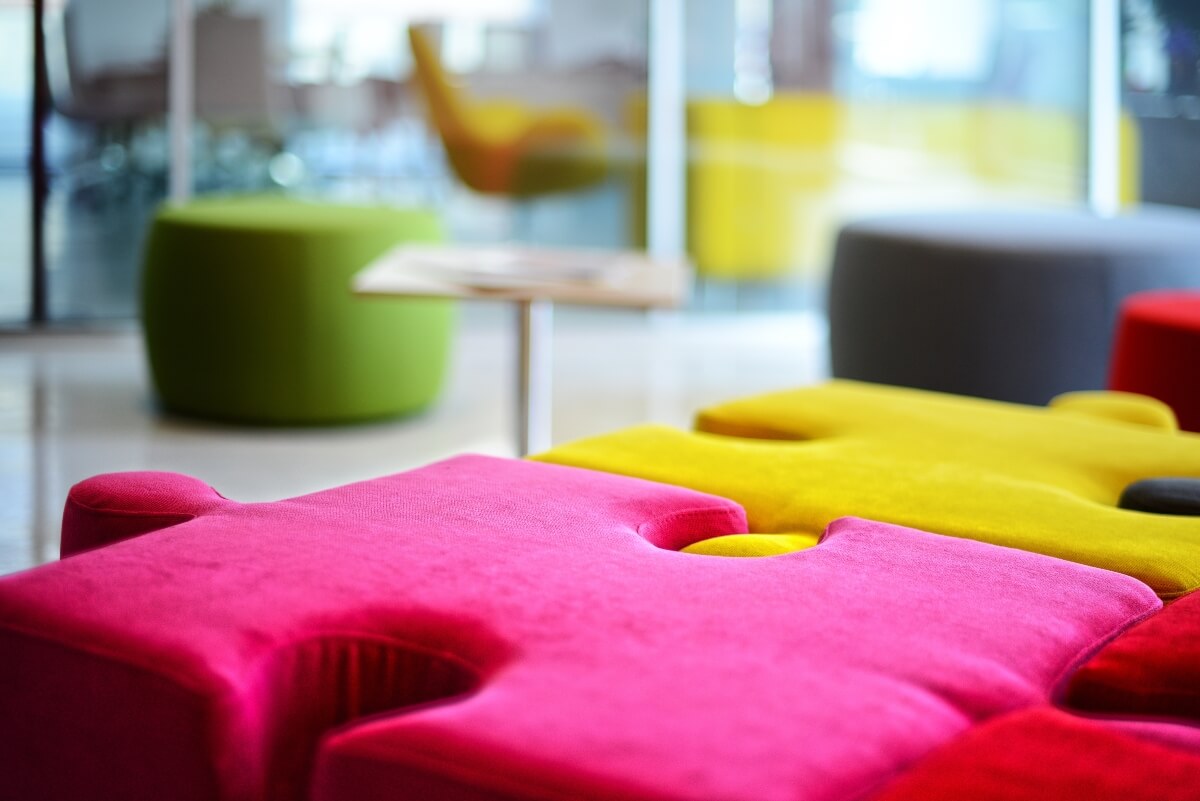Transform your living space into an eco-conscious sanctuary by embracing sustainable home design through thoughtful material choices and creative repurposing. Salvage weathered wood pallets to craft rustic floating shelves, or reimagine vintage furniture pieces with non-toxic, water-based paints for stunning statement pieces. Source organic textiles like hemp, bamboo, and recycled cotton for throw pillows and curtains that combine environmental responsibility with luxurious comfort. Nature-inspired decor elements – from potted plants to locally sourced stone displays – bring the outdoors in while reducing your carbon footprint.
Today’s eco-friendly decorating moves beyond simply choosing green materials; it embraces a holistic approach to creating spaces that nurture both the environment and your wellbeing. By selecting low-VOC paints, reclaimed materials, and energy-efficient lighting solutions, your home becomes a testament to conscious living without sacrificing style or comfort. Whether you’re starting small with upcycled accessories or planning a complete room makeover, sustainable decorating offers endless possibilities to express your creativity while protecting our planet.
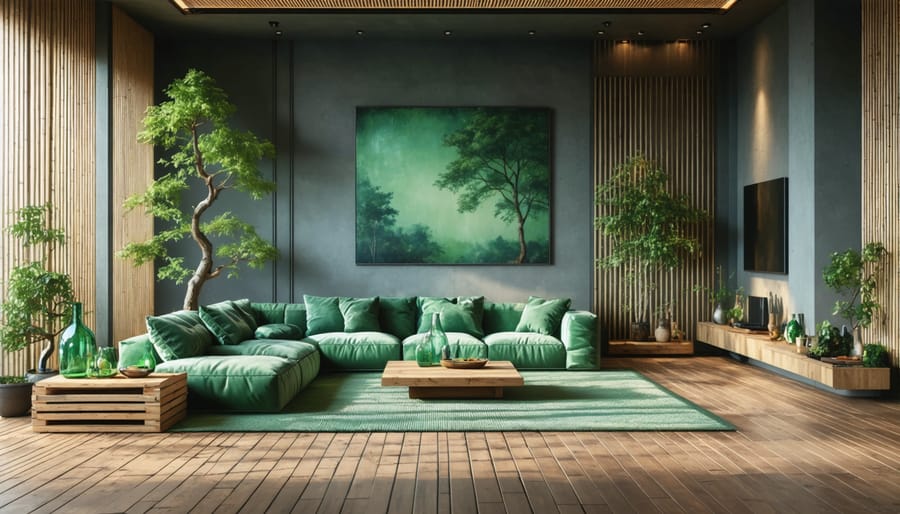
Sustainable Materials That Transform Your Space
Natural and Reclaimed Wood
Natural and reclaimed wood brings timeless warmth and character to your home while helping protect our forests. When shopping for wooden furniture or decor, look for FSC (Forest Stewardship Council) certification, which guarantees the wood comes from responsibly managed forests. Reclaimed wood, salvaged from old buildings, barns, or fallen trees, offers an even more sustainable option while adding unique charm and history to your space.
Consider incorporating elements like barn wood floating shelves, vintage wooden crates as storage solutions, or weathered wood picture frames. For larger pieces, salvaged wood dining tables or accent walls make striking statements while reducing environmental impact. Many local craftspeople specialize in working with reclaimed materials, creating one-of-a-kind pieces that tell a story.
If you’re feeling creative, try DIY projects with pallet wood – just ensure they’re heat-treated (marked with “HT”) rather than chemically treated. Sand thoroughly and seal properly to ensure safety and longevity. Remember, each piece of natural or reclaimed wood is unique, with its own grain patterns and character marks that make your decor truly special.
Bamboo and Cork: Renewable Design Stars
When it comes to sustainable materials that pack both style and environmental benefits, bamboo and cork are leading the charge in eco-friendly home decor. Bamboo, which can grow up to three feet in a single day, offers incredible versatility in home design. From sleek floating shelves to elegant room dividers, bamboo brings a warm, natural aesthetic while being incredibly durable.
Cork, harvested from the bark of cork oak trees without harming them, is another wonder material that’s making waves in conscious decorating. Its natural soundproofing qualities make it perfect for wall panels and flooring, while its unique texture adds visual interest to any space. Plus, it’s naturally antimicrobial and hypoallergenic – perfect for health-conscious homeowners.
Both materials work beautifully in modern and traditional settings. Try bamboo cutting boards as kitchen wall art, or create a cork accent wall in your home office for a functional pin-up space. The best part? These materials are not only renewable but also incredibly affordable, making sustainable design accessible to everyone. When properly maintained, bamboo and cork pieces can last for decades, proving that eco-friendly choices don’t mean compromising on longevity.
Recycled Glass and Metal Accents
Transform your space with stunning accents made from recycled glass and metal. Old wine bottles can become elegant vases or unique pendant lights when carefully cut and polished. Consider displaying collections of colorful glass bottles on window sills to create beautiful light patterns throughout your room. Salvaged metal pieces, like vintage doorknobs or industrial gear wheels, make eye-catching wall art when arranged thoughtfully. For a practical touch, repurpose tin cans into stylish planters or pencil holders by cleaning them thoroughly and adding a coat of eco-friendly paint. Local recycling centers and antique shops are excellent sources for these materials, often offering unique pieces at affordable prices. Remember to sand any sharp edges on metal pieces and properly seal glass items for safety.
Energy-Efficient Lighting Solutions
LED Fixtures That Make a Statement
LED lighting has come a long way from the harsh, clinical bulbs of the past. Today’s LED fixtures are style powerhouses that can transform any room while significantly reducing your carbon footprint. Statement pieces like geometric pendant lights and sculptural floor lamps combine artistic design with energy efficiency, using up to 75% less electricity than traditional lighting.
Consider installing a dramatic LED chandelier in your dining room – these modern marvels can last up to 25 times longer than incandescent bulbs while creating the perfect ambiance for entertaining. For a more subtle approach, LED strip lighting tucked into crown molding or under kitchen cabinets adds a sophisticated glow while consuming minimal energy.
Smart LED fixtures are particularly exciting, offering color-changing capabilities and smartphone control. Imagine adjusting your lighting from warm white for cozy evenings to energizing daylight for productive mornings. Plus, with prices becoming increasingly competitive, these eco-friendly alternatives are more accessible than ever.
When shopping for LED fixtures, look for those with high color rendering index (CRI) ratings to ensure your home’s colors appear rich and true to life. Many contemporary designs now incorporate recyclable materials in their construction, making them an even more sustainable choice.
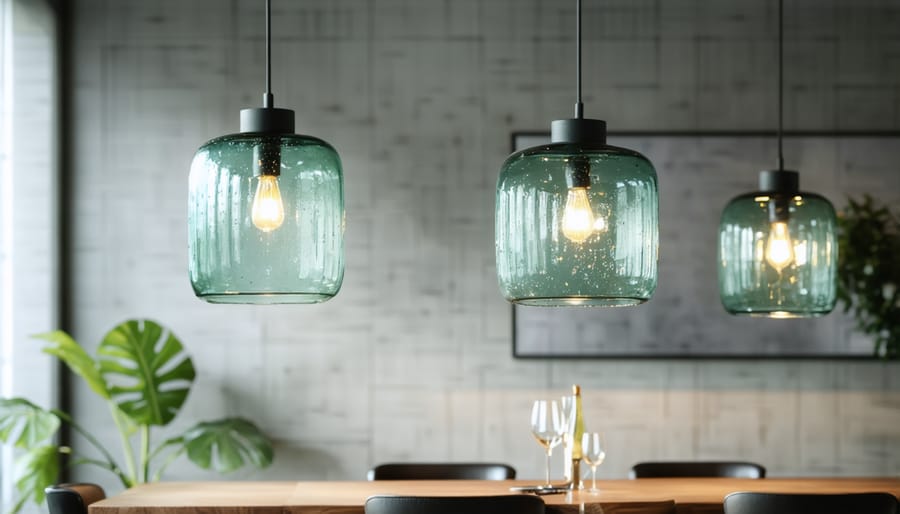
Natural Light Maximization
Maximizing natural light in your home isn’t just about reducing energy bills – it’s a powerful way to create an inviting, eco-friendly space that benefits both your wellbeing and the environment. Start by keeping windows clean and removing any obstacles that might block sunlight. Consider replacing heavy curtains with lightweight, sheer fabrics that filter light while maintaining privacy.
Strategic mirror placement can dramatically enhance natural light. Position mirrors opposite windows to reflect and amplify daylight throughout your space. Light-colored paint on walls and ceilings can also help bounce light around rooms more effectively. Choose glossy or semi-gloss finishes for an extra reflective boost.
For rooms with limited natural light, consider installing glass doors or adding a skylight. Even small changes like trimming outdoor vegetation that blocks windows can make a significant difference. Use light-reflecting décor elements like metallic accessories, glass vases, and crystal pieces to create subtle light-catching points throughout your space.
Remember to arrange furniture thoughtfully – keep taller pieces away from windows and opt for light-colored upholstery to maintain the bright, airy feel of your naturally lit space.
Sustainable Textiles and Fabrics
Organic Cotton and Hemp
Organic cotton and hemp are game-changers when it comes to sustainable home textiles, offering both environmental benefits and timeless style. These natural fabrics bring a soft, inviting texture to your living spaces while significantly reducing your home’s ecological footprint.
Organic cotton stands out for its chemical-free growing process and biodegradability. Perfect for throw pillows, curtains, and bedding, it creates a cozy atmosphere while being gentle on sensitive skin. Look for GOTS-certified organic cotton products to ensure the highest environmental and social standards.
Hemp is nature’s super-fiber, requiring minimal water and no pesticides to grow. This durable material is perfect for upholstery, rugs, and decorative wall hangings. Its natural resistance to mold and mildew makes it ideal for high-moisture areas, while its ability to soften over time ensures lasting comfort.
Both materials work beautifully in neutral color schemes and can be easily dyed with natural pigments for more vibrant decor options. Try mixing organic cotton throws with hemp accent pillows for an eco-chic layered look, or use hemp curtains paired with organic cotton cushions to create a harmonious, sustainable space that feels as good as it looks.
Recycled and Upcycled Textile Art
Transform your old textiles into stunning home decor pieces while reducing waste and adding unique character to your space. Start by collecting worn-out clothing, bedsheets, curtains, or fabric scraps that would otherwise end up in landfills. These materials can become beautiful wall hangings, decorative pillows, or even striking quilted throws.
Create eye-catching wall art by stretching colorful fabric pieces over canvas frames or embroidery hoops. Mix patterns and textures to achieve an eclectic look, or stick to a cohesive color scheme for a more polished appearance. Old denim can be woven into sturdy rugs, while vintage scarves can be transformed into unique lampshade covers.
For a quick weekend project, try making patchwork cushion covers from fabric scraps or repurpose old sweaters into cozy throw pillows. Tea towels and tablecloths can find new life as decorative bunting or window valances. Consider creating a memory wall by framing meaningful textile pieces, like your child’s favorite outgrown clothing or inherited family linens.
Remember to clean and iron all fabrics before crafting, and use appropriate backing materials to ensure your creations last. Simple hand-sewing skills are usually sufficient for most projects, making this an accessible way to add sustainable charm to your home.
Living Decor Elements
Air-Purifying Plants
Transform your home into a natural air-filtration system by incorporating these beautiful air-purifying plants. The NASA-tested Spider Plant is a low-maintenance champion at removing common indoor pollutants, while the elegant Peace Lily adds a touch of sophistication while filtering out harmful chemicals. Snake Plants, with their striking vertical leaves, work overtime by converting CO2 to oxygen even at night, making them perfect for bedrooms.
For larger spaces, the dramatic Rubber Plant not only removes air toxins but also serves as a stunning focal point. The cascading pothos is ideal for shelves or hanging baskets, efficiently cleaning the air while creating visual interest at different heights. When it comes to styling indoor plants, consider grouping different varieties to create a mini indoor forest that maximizes air-purifying benefits.
Choose ceramic or recycled pots to enhance their eco-friendly impact, and position plants near potential pollution sources like printers or high-traffic areas. Remember to dust leaves monthly to maintain their air-cleaning efficiency and keep them looking their best. With these green allies, you’ll create a healthier, more vibrant living space naturally.
Vertical Gardens and Living Walls
Transform your living space into a breathtaking natural sanctuary with vertical gardens and living walls. These stunning eco-friendly features not only add a dramatic visual element to your home but also improve air quality and create a stronger connection with nature. Whether you’re working with a small apartment or a spacious house, you can find plenty of living wall inspiration to suit your space and style.
Start small with modular wall planters or ready-made pocket systems that allow you to grow herbs, succulents, or air-purifying plants. For a low-maintenance option, consider preserved moss walls that require no watering while still delivering that lush, green aesthetic. If you’re feeling ambitious, install a complete hydroponic system with built-in irrigation for a more diverse plant selection.
Choose hardy, low-maintenance plants like pothos, ferns, and philodendrons for beginners. Mix different leaf shapes, sizes, and shades of green to create visual interest. Remember to position your living wall where it can receive appropriate lighting, and consider installing a simple drip irrigation system to make maintenance easier.
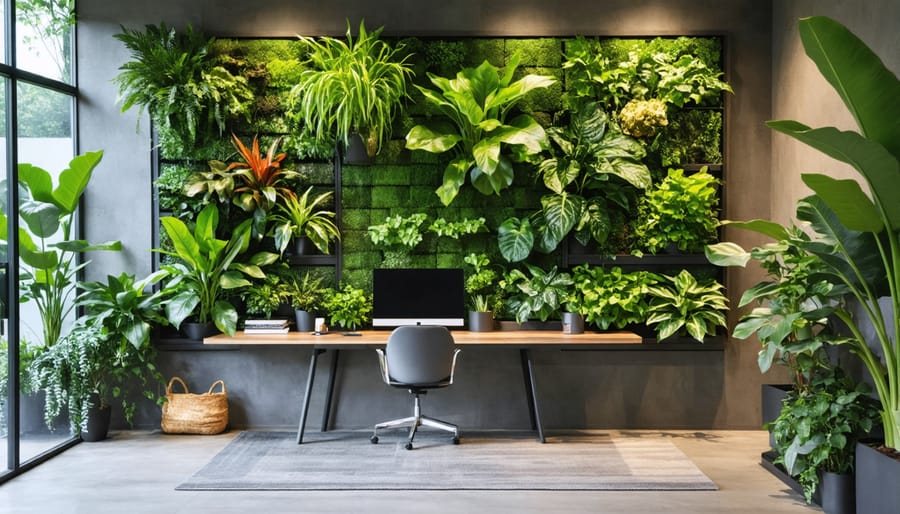
DIY Eco-Friendly Decor Projects
Transform your living space with these creative and budget-friendly DIY projects that put sustainability at the forefront. Start with a stunning vertical garden using recycled wooden pallets – simply sand them down, add a protective eco-friendly sealant, and attach small planters made from tin cans or mason jars. Fill them with air-purifying indoor plants for both beauty and function.
Create unique wall art by pressing dried flowers and leaves between recycled glass frames, or arrange driftwood pieces into an eye-catching sculptural display. For a cozy touch, craft throw pillows using organic cotton fabric scraps or repurposed clothing, stuffed with natural materials like buckwheat hulls or organic cotton batting.
Transform empty wine bottles into elegant vases by painting them with non-toxic chalk paint, or create striking candle holders by cutting them carefully with a glass cutter. Old magazines can become beautiful paper flowers or geometric wall installations – just fold and arrange them thoughtfully.
Make your own natural air fresheners by creating potpourri from dried organic flowers, citrus peels, and essential oils. Display them in repurposed glass containers or create sachets using old fabric scraps. For statement pieces, try crafting a macramé wall hanging using organic cotton cord or turning reclaimed wood into floating shelves.
Remember to source materials responsibly – check local thrift stores, yard sales, or neighborhood exchange groups for supplies. These projects not only reduce waste but also add character to your home while reflecting your commitment to environmental consciousness.
Transforming your home into an eco-friendly sanctuary doesn’t have to be overwhelming or expensive. As we’ve explored throughout this guide, sustainable decorating is about making mindful choices that benefit both your living space and the planet. By incorporating natural materials, choosing second-hand treasures, and embracing DIY projects, you can create a beautiful, environmentally conscious home that reflects your personal style.
Remember that every small change matters. Start with simple swaps like choosing organic cotton textiles, upcycling existing furniture, or adding air-purifying plants to your space. As you become more comfortable with sustainable decorating, you can gradually implement larger changes, such as investing in solar-powered lighting or installing reclaimed wood features.
The key to successful eco-friendly decorating lies in being intentional with your choices. Before making any purchase, consider its environmental impact, longevity, and whether you might find a more sustainable alternative. Don’t feel pressured to transform your entire home overnight – sustainable decorating is a journey, not a destination.
By choosing eco-friendly decor options, you’re not just creating a healthier living environment for yourself and your family; you’re contributing to a larger movement toward sustainable living. Let your creativity flourish as you experiment with natural materials, repurposed items, and environmentally conscious designs. Your home can be both beautiful and kind to the planet – it’s simply a matter of making conscious choices, one decoration at a time.

